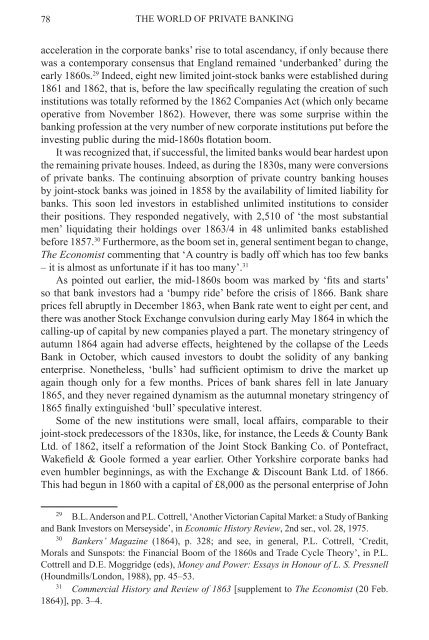the world of private banking
the world of private banking
the world of private banking
Create successful ePaper yourself
Turn your PDF publications into a flip-book with our unique Google optimized e-Paper software.
78<br />
THE WORLD OF PRIVAtE BANKING<br />
acceleration in <strong>the</strong> corporate banks’ rise to total ascendancy, if only because <strong>the</strong>re<br />
was a contemporary consensus that England remained ‘underbanked’ during <strong>the</strong><br />
early 1860s. 29 Indeed, eight new limited joint-stock banks were established during<br />
1861 and 1862, that is, before <strong>the</strong> law specifically regulating <strong>the</strong> creation <strong>of</strong> such<br />
institutions was totally reformed by <strong>the</strong> 1862 Companies Act (which only became<br />
operative from November 1862). However, <strong>the</strong>re was some surprise within <strong>the</strong><br />
<strong>banking</strong> pr<strong>of</strong>ession at <strong>the</strong> very number <strong>of</strong> new corporate institutions put before <strong>the</strong><br />
investing public during <strong>the</strong> mid-1860s flotation boom.<br />
It was recognized that, if successful, <strong>the</strong> limited banks would bear hardest upon<br />
<strong>the</strong> remaining <strong>private</strong> houses. Indeed, as during <strong>the</strong> 1830s, many were conversions<br />
<strong>of</strong> <strong>private</strong> banks. The continuing absorption <strong>of</strong> <strong>private</strong> country <strong>banking</strong> houses<br />
by joint-stock banks was joined in 1858 by <strong>the</strong> availability <strong>of</strong> limited liability for<br />
banks. This soon led investors in established unlimited institutions to consider<br />
<strong>the</strong>ir positions. They responded negatively, with 2,510 <strong>of</strong> ‘<strong>the</strong> most substantial<br />
men’ liquidating <strong>the</strong>ir holdings over 1863/4 in 48 unlimited banks established<br />
before 1857. 30 Fur<strong>the</strong>rmore, as <strong>the</strong> boom set in, general sentiment began to change,<br />
The Economist commenting that ‘A country is badly <strong>of</strong>f which has too few banks<br />
– it is almost as unfortunate if it has too many’. 31<br />
As pointed out earlier, <strong>the</strong> mid-1860s boom was marked by ‘fits and starts’<br />
so that bank investors had a ‘bumpy ride’ before <strong>the</strong> crisis <strong>of</strong> 1866. Bank share<br />
prices fell abruptly in December 1863, when Bank rate went to eight per cent, and<br />
<strong>the</strong>re was ano<strong>the</strong>r Stock Exchange convulsion during early May 1864 in which <strong>the</strong><br />
calling-up <strong>of</strong> capital by new companies played a part. The monetary stringency <strong>of</strong><br />
autumn 1864 again had adverse effects, heightened by <strong>the</strong> collapse <strong>of</strong> <strong>the</strong> Leeds<br />
Bank in October, which caused investors to doubt <strong>the</strong> solidity <strong>of</strong> any <strong>banking</strong><br />
enterprise. None<strong>the</strong>less, ‘bulls’ had sufficient optimism to drive <strong>the</strong> market up<br />
again though only for a few months. Prices <strong>of</strong> bank shares fell in late January<br />
1865, and <strong>the</strong>y never regained dynamism as <strong>the</strong> autumnal monetary stringency <strong>of</strong><br />
1865 finally extinguished ‘bull’ speculative interest.<br />
Some <strong>of</strong> <strong>the</strong> new institutions were small, local affairs, comparable to <strong>the</strong>ir<br />
joint-stock predecessors <strong>of</strong> <strong>the</strong> 1830s, like, for instance, <strong>the</strong> Leeds & County Bank<br />
Ltd. <strong>of</strong> 1862, itself a reformation <strong>of</strong> <strong>the</strong> Joint Stock Banking Co. <strong>of</strong> Pontefract,<br />
Wakefield & Goole formed a year earlier. O<strong>the</strong>r Yorkshire corporate banks had<br />
even humbler beginnings, as with <strong>the</strong> Exchange & Discount Bank Ltd. <strong>of</strong> 1866.<br />
This had begun in 1860 with a capital <strong>of</strong> £8,000 as <strong>the</strong> personal enterprise <strong>of</strong> John<br />
29<br />
B.L. Anderson and P.L. Cottrell, ‘Ano<strong>the</strong>r Victorian Capital Market: a Study <strong>of</strong> Banking<br />
and Bank Investors on Merseyside’, in Economic History Review, 2nd ser., vol. 28, 1975.<br />
30<br />
Bankers’ Magazine (1864), p. 328; and see, in general, P.L. Cottrell, ‘Credit,<br />
Morals and Sunspots: <strong>the</strong> Financial Boom <strong>of</strong> <strong>the</strong> 1860s and Trade Cycle Theory’, in P.L.<br />
Cottrell and D.E. Moggridge (eds), Money and Power: Essays in Honour <strong>of</strong> L. S. Pressnell<br />
(Houndmills/London, 1988), pp. 45–53.<br />
31<br />
Commercial History and Review <strong>of</strong> 1863 [supplement to The Economist (20 Feb.<br />
1864)], pp. 3–4.












![[Pham_Sherisse]_Frommer's_Southeast_Asia(Book4You)](https://img.yumpu.com/38206466/1/166x260/pham-sherisse-frommers-southeast-asiabook4you.jpg?quality=85)



